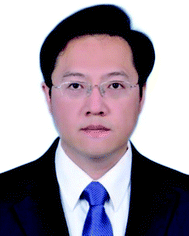Introduction to Antibacterial Biomaterials
Jianfeng
Cai
 *a and
Runhui
Liu
*a and
Runhui
Liu
 *b
*b
aDepartment of Chemistry, University of South Florida, Tampa, FL 33620, USA. E-mail: jianfengcai@usf.edu
bFrontiers Science Center for Materiobiology and Dynamic Chemistry, Key Laboratory of Specially Functional Polymeric Materials and Related Technology (ECUST) Ministry of Education, School of Materials Science and Engineering, East China University of Science and Technology, Shanghai 200237, China. E-mail: rliu@ecust.edu.cn
However, due to the overuse and abuse of antibiotics, the emergence of drug-resistant strains has brought great pressure to public health systems all over the world. Since the pace of developing new antimicrobial agents can hardly keep up with the development of bacterial resistance, it is increasingly recognized that the “post-antibiotic era” is coming, and the failure of antibiotic treatment will have a significant impact on society and the economy. According to reports, about 700![[thin space (1/6-em)]](https://www.rsc.org/images/entities/char_2009.gif) 000 patients die from drug-resistant bacteria worldwide each year. It is predicted that by 2050, drug-resistant microbes will cause 10 million deaths and the economic loss will exceed $100 trillion. Therefore, there is an urgent need to develop new antibacterial biomaterials to increase the selectivity of bacteria and reduce drug resistance. However, due to high development costs and long development cycles, and relatively low return on investment, pharmaceutical industries are reducing their efforts to develop new antibiotics.
000 patients die from drug-resistant bacteria worldwide each year. It is predicted that by 2050, drug-resistant microbes will cause 10 million deaths and the economic loss will exceed $100 trillion. Therefore, there is an urgent need to develop new antibacterial biomaterials to increase the selectivity of bacteria and reduce drug resistance. However, due to high development costs and long development cycles, and relatively low return on investment, pharmaceutical industries are reducing their efforts to develop new antibiotics.
Usually antibiotics achieve bacteriostatic or bactericidal effects by affecting the metabolic processes of microbes (such as the synthesis of cell walls, cell membranes, proteins, DNA and RNA). The mechanisms of microbial resistance could be as follows: microbes produce inactivated enzymes, which can destroy the structure of drugs; a change in the drug target making the drug lose its action site; blocking drug penetration; removal of the drug from the microbe through the efflux pump; forming microbial biofilms, which can allude the immune function of the host in the infected part. According to the mechanisms of microbial resistance, a research upsurge of non-antibiotic therapies is brewing. A variety of antibacterial biomaterials are emerging: (1) inorganic antibacterial biomaterials – metal nanoparticles, such as silver nanoparticles, zinc oxide nanoparticles, etc.; (2) polymer biomaterials – quaternary ammonium salt derivatives, polyethyleneimine derivatives, host defence peptides (HDPs) or antimicrobial peptides (AMPs), HDP/AMP mimics, etc.; (3) small molecule antibacterial biomaterials – antibiotic derivatives, etc. These biomaterials achieve bacteriostatic or bactericidal effects by: inhibiting the formation of biofilms by interacting with cell walls, disrupting the cell wall of the microbe, triggering an innate and adaptive immune response, producing reactive oxygen species (ROS) and inducing intracellular activity (interacting with DNA to hinder the function of protein) and so on.
This themed collection containing reviews and research articles focuses on the selection of antibacterial biomaterial designs and applications.
Ag-based materials have shown efficient and broad spectrum antibacterial effects. P. Liu and K. Cai incorporated Ag nanoparticles into mesoporous silica nanoparticles (MSNs). The Ag nanoparticle-incorporated MSNs were deposited on the surface of polydopamine-modified Ti substrates to eliminate infections associated with biological materials. Silver ions were controllably released on demand under the action of enzymes at the site of infection [DOI: 10.1039/C9BM01924C].
Most quaternary ammonium or primary amine-based polymers show antimicrobial activity, and their antimicrobial activity is based on membrane lysis. Y. Yang synthesized quaternary ammonium and guanidinium homopolymers and copolymers, and studied the antibacterial mechanism [DOI: 10.1039/D0BM00752H].
ε-Polylysine (ε-PL), a typical antimicrobial peptide composed of 25–35 lysine residues, showed antimicrobial capability though electrostatic adsorption on the bacterial membrane and leakage of the cytoplasm. L. Xue and P. Yang immobilized ε-PL on the surface of medical materials through the aqueous supramolecular assembly of bovine serum albumin (BSA) which formed a coating. This coating not only exhibited effective antibacterial activity, but also showed excellent antifouling properties [DOI: 10.1039/D0BM00760A]. HDPs/AMPs, are an important part of the innate immune system, with advantages of broad-spectrum antimicrobial activity and low drug resistance, and are one of the most promising antibacterial agents. However, the high cytotoxicity of HDPs/AMPs towards mammalian cells limits their application. R. Liu synthesized an α/β chimeric polypeptide molecular brush using poly-β-peptide as the backbone grafted with poly-L-lysine, which effectively eradicates established biofilms, and kills persistent cells and clinically isolated multi-drug resistant Gram-positive bacteria [DOI: 10.1039/D0BM01211D]. Y. Bao and M. Xiong summarized the impact of secondary structures on the antibacterial activity and cytotoxicity of AMPs/HDPs, providing a basis for the rational design of highly selective AMPs optimising the balance between antimicrobial activity and cytotoxicity towards mammalian cells [DOI: 10.1039/D0BM00801J].
Bacterial infection of artificial organs and medical polymer materials implanted in the human body is also one of the main problems facing medicine. Bacterial invasion of implants is often the main cause of reoperation and medical malpractice. In this issue, K. Ren and J. Ji provide a review on functionalized biomaterials to combat biofilms [DOI: 10.1039/D0BM00526F]. Y. Zhang and Q. Yu summarized multi-functional photothermal bactericidal surfaces [DOI: 10.1039/D0BM00617C]. In addition, H. Shi and S. Luan applied surface antibacterial strategies for biomedical catheters [DOI: 10.1039/D0BM00659A].
Last but not least, nanomaterials are also important antibacterial biomaterials. Q. Jin and A. Dong discussed the application of nanomaterials in the antibacterial field from different aspects [DOI: 10.1039/D0BM00974A and DOI: 10.1039/D0BM00788A].
There might be more review and research articles which will be added into this themed issue and are not mentioned above when this editorial is published. However, they are equally important in addressing the development of antibacterial biomaterials.
In summary, this themed issue on “antibacterial biomaterials” introduces the design and application of a variety of new antibacterial materials and offers an overview of various advanced strategies. The aim of this issue is to offer some meaningful insight into the field of antibacterial materials and provide new ideas for the clinical use of antibacterial materials.
Author biographies:
| This journal is © The Royal Society of Chemistry 2020 |


